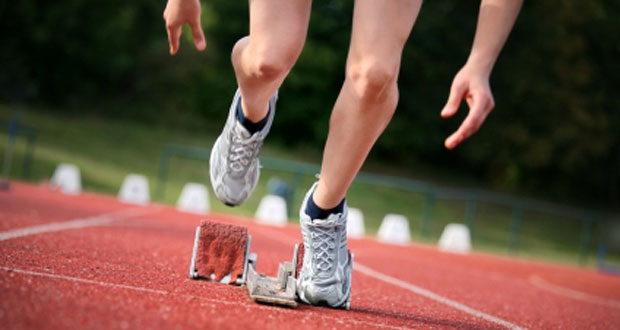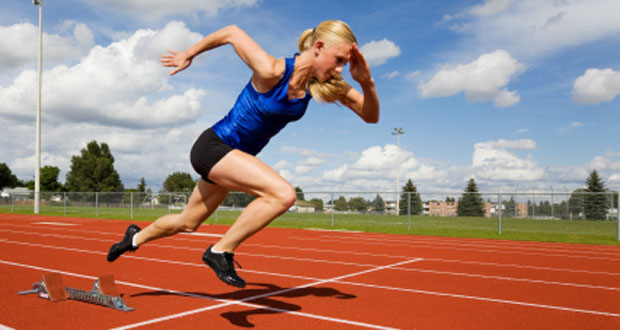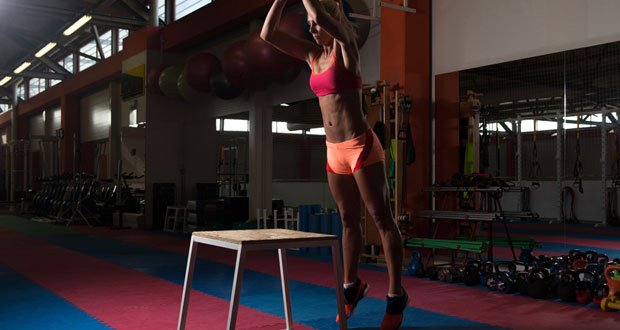Can you really run faster than your top speed? Overspeed training uses bungee-type devices, downhill runs, strong following winds, super-fast treadmills and even car towing to allow an athlete to sprint faster than what they could do normally.
Who could benefit?
Somewhat obviously sprinters, long and triple jumpers and hurdlers but overspeed is applicable to ‘athletes’ from other sports i.e. football and rugby. Note: it’s possible to overspeed-train jumping, cutting and other agility movements and even throwing ones – this is a subject area beyond the scope of this post.
Why overspeed train?
It’s hoped that enabling an athlete to sprint faster than their unassisted top speed will boost unassisted top speed. This transference is believed to be a consequence of improved muscle rate of firing (the athlete can move their arms and legs more quickly); improved neuromuscular coordination (the athlete’s neural system will be able to work at higher speeds – there will be enhanced signaling); and through improvements relating to sprint technique i.e. decreased ground contact time and the ability to impart more force onto the running surface in that decreased contact time.
Does it work?
Most of the sports science until quite recently tended to indicate that in terms of overspeed’s intended purpose i.e. creating an athlete who could run more quickly, it doesn’t work. This needs clarification: the athlete may actually run faster if they are being towed, for example, however, they may not actually be sprinting in the most effective way to the transference which will actually boost their unassisted speed. Nor may they may making themselves run more quickly. What do we mean?
Well, rather like putting your car in neutral and letting it run down a steep hill, it’s momentum, not the car’s engine nor you as a driver that’s making the car speed up. Gravity is doing the work. To sprint faster an athlete needs to make the movements happen; they need to drive their arms and pull their legs through from back to front as fast as possible to create velocity. When running overspeed, rather like the car freewheeling down that steep hill, the work in many ways is being done for them, and they were at best coasting and at worst slightly out of control.
More problems with overspeed training
One of the chief criticisms of overspeed is that it negatively
effects sprint technique. How so? Well, contrary to what you actually
want, ground contact times can be increased and sprint mechanics further
negatively altered, for example, by overstriding.
If you were to
run down a hill the chances are that you would let your feet move in
front of your centre of mass to put the brakes on. You may also lean
backwards and let your feet strike the ground in a toes-down position
again to control your descending speed. And this is what can happen
albeit in a less obvious fashion when sprinting overspeed.
New research presents a possible way to make overspeed training actually work (but it’s highly involved equipment wise)
Some
fledgling research has appeared in the last few years on a brand new
concept in overspeed – specifically, the use of elastic towing combined
with a parachute that lifts the athlete to reduce drag (1). The validity
of this research is strengthened by the fact that it involved 19 elite
Austrian male sprinters.
The researchers used three 20m sprint conditions:
- unassisted sprint
- bodyweight supported sprint with kite
- overspeed bodyweight sprint supported with kite
Sprint biomechanics were factored into the analysis together with various time and velocity parameters. The results: for the bodyweight kite supported sprint, ground contact time decreased (5.8%) and air-time increased (5.79%); although running velocity, step length and step frequency were no different to the sprinter’s normal unassisted capability. However, when it came to the overspeed bodyweight kite supported runs ground contact time decreased (7.66%), whilst running velocity, airtime, step length, and step frequency all equally positively increased by 2.72%, 4.92%, 1.98%, 1.05% respectively. The researchers had this to say: “… sprinting with a body-weight supporting kite appeared to be a highly specific method to simulate an advanced performance level, indicated by higher running velocities requiring reduced ground contact times.
The additional application of an overspeed condition led to a further reduction of ground contact time. Therefore, we recommend body-weight supported sprinting as an additional tool in sprint training.”
DIY overspeed
Find a hill, considerations on angle of descent. Most overspeed research which looks at angle of descent favours a very shallow angle for downhill sprints – 3% or less (2). Research has looked at steeper angles and there’s a bit of obviousness to some of the findings. US researchers, for example, looked at the effects 3.3-, 4.7-, 5.8- and 6.9-degree gradients had on NCAA Division 3 soccer, track and (US) football athletes (3). Tests were performed over 40 yards (36.6m). It was discovered that the 5.8-degree slope produced the quickest times – specifically, times were on average 0.35 secs quicker than the athletes could achieve on the flat. But if you think about it, so it should be as we have our friend gravity literally offering a helping hand (and too much on the steeper gradients).
How overspeed could benefit athletes in unintended ways
So far, unless you are able to utilize the high-tech system that the kite flying overspeed sports scientists have as mentioned, then the specific, direct, hoped-for outcomes of overspeed running are not actually likely to happen. However, there may be unintended and less obvious benefits. These relate to landing forces – specifically as an outcome of an increase in eccentric force capability (an eccentric muscular action is a lengthening one and it’s integral to power production and the subsequent speed of the muscle shortening concentric action that’s involved in running and jumping).
Eccentric forces in both the vertical and horizontal plane when running overspeed have been identified as being greater than when running on the flat (4). This added eccentric activity could enhance the stretch/reflex of the athlete’s sprinting muscles – thus overspeed training could be seen more like weights as a way to condition speed, rather than as a direct enhancer of speed. The stretch/reflex refers to the eccentric-to-concentric pairing of muscular actions that occur in the muscles of the ankles, knees, and hips when sprinting and jumping, for example. Further research substantiates the role that eccentric and overspeed training can have when combined in a training programme (5). Specifically this combination, for example, has been shown to improve counter-movement jump peak power. (It was noted by the researchers that the overspeed training did not actually enhance sprint speed.)
Improvements in eccentric capability could, as indicated improve
jumping, and rather paradoxically sprint performance. If an athlete can
yield less on ground contact when the muscles go on stretch and return
energy more quickly from the running surface then they are likely to
have increased speed.
One final possible positive – potentiation.
Overspeed sprinting can fire up the athlete’s neuromuscular system and
it’s possible that a couple of overspeed sprints will heighten the
athlete’s responses and this may lead to fast/faster on the flat times
in the same training session. Rather like weights can enhance
(potentiate) the response of closely followed and matched for movement
pattern plyometric (jumping) exercises it’s possible that overspeed work
may do the same.
The over & out on overspeed…
So, it’s a bit of a “it logically should work but doesn’t seem to”
when it comes to the direct value of overspeed as a means to improve
sprint speed.
Consequentially it’s recommended that overspeed be
used sparingly by the suitably conditioned athlete and in as effective a
way as possible so that sprint mechanics are not significantly altered.
This would mean limited overspeed assistance in terms of gradient or
bungee pull strength or with the use of lifting parachutes, which would
probably be beyond the realms of most athletes and establishments (this
being the one overspeed condition that may actually do what it’s claimed
to).
It’s also recommended that sprints without assistance be performed in the same training session to improve any potential, albeit unlikely direct, transferability of the overspeed work. Consideration should also be made of the eccentric and potentiating potential of overspeed in terms of conditioning benefits.




